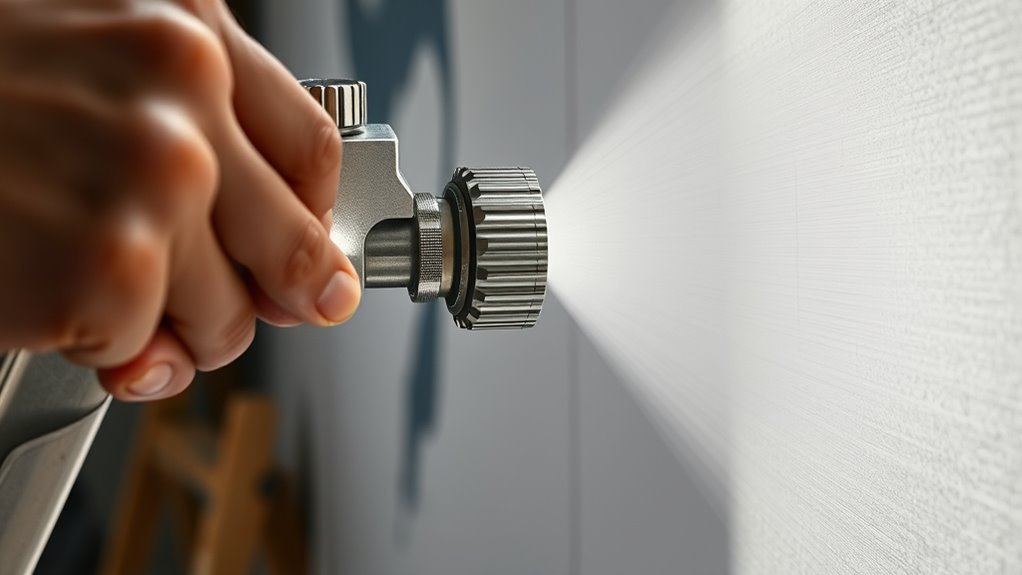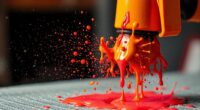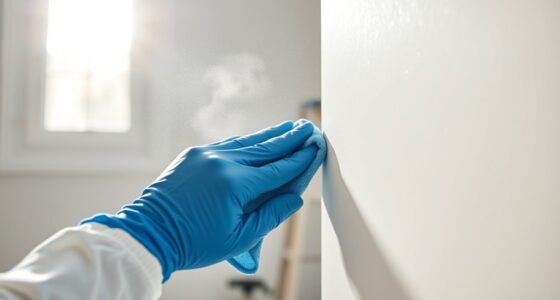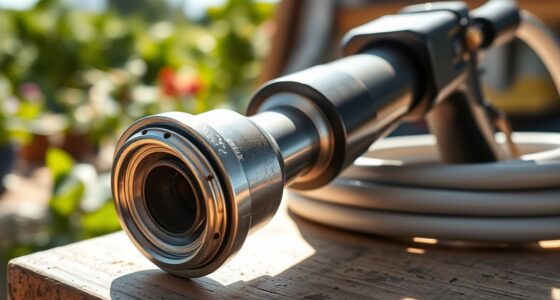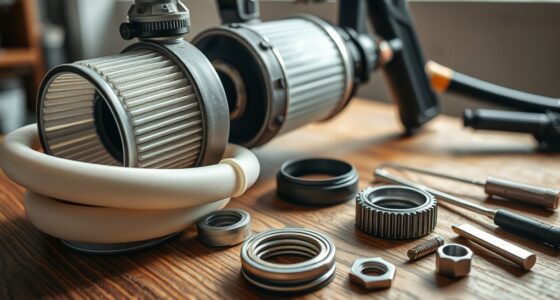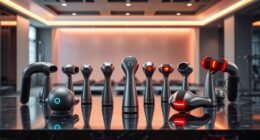To calibrate your paint sprayer’s pressure and spray pattern, start by selecting the right nozzle size for your project. Follow the manufacturer’s recommendations for initial pressure settings, and use a pressure gauge to verify accuracy. Spray onto a test surface or drop cloth, adjusting the pressure until you get a smooth, even spray pattern without runs or dry spots. Fine-tuning these settings guarantees professional results—continue exploring to master perfect calibration techniques.
Key Takeaways
- Refer to the manufacturer’s guidelines to set initial pressure and select compatible nozzles.
- Fill the sprayer with test paint and use a pressure gauge to verify recommended pressure levels.
- Adjust the pressure control and nozzle size based on spray pattern testing on scrap material.
- Use adjustable nozzles or pattern selectors to fine-tune spray width and consistency.
- Continuously test and modify settings during the project to achieve an even, uniform spray pattern.

Have you ever struggled with uneven paint coverage or wasted material? If so, calibrating your paint sprayer properly can make all the difference. One of the key factors influencing a smooth, even finish is controlling the paint flow, which depends heavily on the right nozzle selection. The nozzle controls how much paint is sprayed and the pattern it creates, so choosing the correct one is essential before you start calibrating.
Start by examining your sprayer’s nozzle. Different projects call for different nozzle sizes and types—larger nozzles deliver more paint for broad surfaces, while smaller ones are better for detailed work. Make sure you select a nozzle suited for your project’s needs. Once you have the right nozzle installed, check the manufacturer’s recommended settings, but don’t rely solely on those. You need to fine-tune the paint flow to ensure a consistent spray pattern and avoid runs or thin spots.
Choosing the right nozzle size is essential for achieving perfect coverage and detail in your project.
To calibrate the paint flow, fill your sprayer with a test amount of paint and set the pressure to the recommended level. Most sprayers have a pressure gauge; use it to ensure you’re at the correct pressure. Now, trigger the sprayer onto a piece of scrap material or a drop cloth. Observe the spray pattern and the amount of paint being delivered. If the pattern is uneven or the coverage is inconsistent, adjust the pressure control or the nozzle size accordingly. Increasing pressure generally increases paint flow, resulting in a wider spray pattern, while decreasing it provides a more controlled, narrower spray.
Next, focus on the spray pattern. Proper calibration involves adjusting the nozzle or the sprayer’s settings to produce a uniform, symmetrical pattern. Many sprayers have adjustable nozzles or pattern selectors—use these to refine the spray to your desired width. Spray onto a test surface and check for even distribution. If you notice streaks, dry spots, or overspray, tweak the settings slightly until the pattern becomes uniform. Additionally, understanding the importance of color accuracy and how it impacts your project’s final appearance can help you choose the right spray settings for optimal results.
Frequently Asked Questions
How Often Should I Calibrate My Paint Sprayer?
You should calibrate your paint sprayer whenever you notice uneven spray patterns or inconsistent paint flow, especially if you’re changing paint types or colors. Regular calibration ensures proper spray pattern and paint consistency. Also, check your nozzle selection to match your project needs. For maximum results, calibrate before each major project or after cleaning and maintenance to keep your sprayer performing at its best.
Can I Calibrate Without Professional Tools?
Ever wondered if you can DIY calibration without professional tools? The answer is yes, but it’s a bit tricky. You can try tool alternatives like a manometer or a simple pressure gauge, but they might not be perfectly accurate. Be cautious; improper calibration could ruin your finish. If precision matters, investing in proper calibration tools or consulting a professional guarantees your sprayer operates at its best.
What Are Signs of Incorrect Spray Pattern?
You’ll notice signs of an incorrect spray pattern through spray inconsistency and uneven coverage. If your paint comes out patchy or drips in certain areas, it indicates the pattern isn’t right. You might also see overspray or areas with too little paint. These issues suggest you need to check and adjust your sprayer’s settings, ensuring a smooth, even application and professional-looking finish.
Does Calibration Affect Spray Longevity?
They say “measure twice, cut once,” and calibration is no different. Yes, calibration affects spray longevity because maintaining pressure consistency and spray accuracy prevents uneven wear and clogs. When you regularly calibrate your sprayer, you ensure it operates smoothly, reducing strain on parts. This not only prolongs your equipment’s life but also guarantees a professional finish every time. So, stay consistent—you’ll save time and money in the long run.
Is Calibration Different for Indoor and Outdoor Projects?
Indoor vs outdoor calibration can differ mainly due to environmental impact. Indoors, you might need to adjust your sprayer for more controlled conditions, while outdoors, factors like wind, temperature, and humidity affect spray pattern and pressure. You should calibrate your paint sprayer accordingly, ensuring consistent results regardless of the environment. Proper calibration helps achieve a smooth finish and prevents overspray or paint waste, especially when working outside where conditions are less predictable.
Conclusion
Now that you’ve calibrated your paint sprayer, you’re practically a superhero in the world of DIY. With perfectly adjusted pressure and spray pattern, your projects will transform from mere walls into masterpieces so flawless they could make the Sistine Chapel jealous. Remember, this isn’t just about painting; it’s about releasing your inner artist and conquering every surface with the precision of a master. So go ahead, spray away, and turn your space into a work of art that’ll leave everyone breathless!
Franz came aboard the Paint Sprayer Zone team with a background in both journalism and home renovation. His articulate writing style, combined with a passion for DIY projects, makes him an invaluable asset. Franz has a knack for breaking down technical jargon into easy-to-understand content, ensuring that even the most novice of readers can grasp the complexities of paint sprayers.
